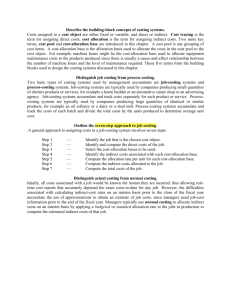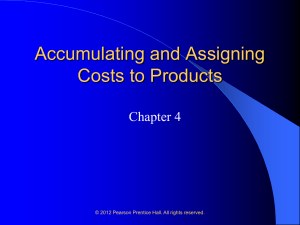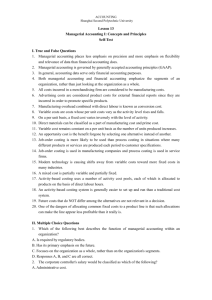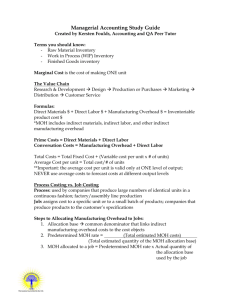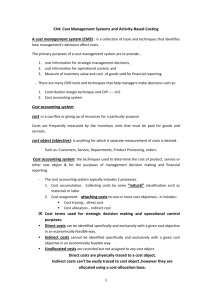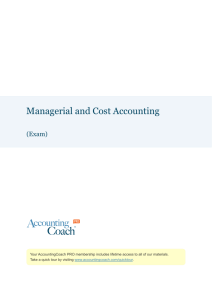Strategic Transfer Pricing, Absorption Costing and Vertical Integration
advertisement
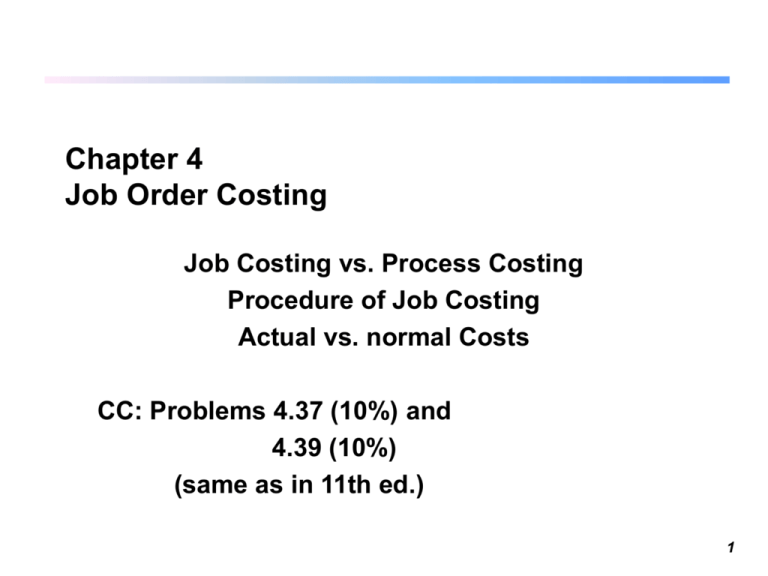
Chapter 4 Job Order Costing Job Costing vs. Process Costing Procedure of Job Costing Actual vs. normal Costs CC: Problems 4.37 (10%) and 4.39 (10%) (same as in 11th ed.) 1 Building Block Concepts of Costing Systems The following five terms constitute the building blocks that will be used in this chapter: 1 2 3 4. 5 A cost object is anything for which a separate measurement of costs is desired. Direct costs of a cost object are costs that are related to the particular cost object and can be traced to it in an economically feasible way. Indirect costs of a cost object are costs that are related to the particular cost object but cannot be traced to it in an economically feasible way. Cost pool is a grouping of individual cost items. Cost allocation base is a factor that is the common denominator for systematically linking an indirect cost or group of indirect costs to a cost object. 2 Relationships between Building Block Concepts Cost Assignment Direct Costs Cost Tracing Indirect Costs Cost Allocation . . . Different Cost Pools use different allocation bases Cost Object using allocation bases 3 Job-Costing and Process-Costing Systems There are two basic systems used to assign costs to products or services: 1 Job costing In a job-costing system, the cost object is an individual unit, batch, or lot of a distinct product or service called a job. 2 Process costing In process costing, the cost object is masses of identical or similar units of a product or service. Process costing allocates costs among all the products manufactured during that period. 4 General Approach to Job Costing The following seven-steps approach is used to assign actual costs to individual jobs: Identify the chosen cost object(s). 2 Identify the direct costs of the job. 3 Select the cost-allocation base(s). 4 Identify the indirect costs associated with each cost-allocation base 5 Compute the rate per unit of each cost-allocation base used to allocate indirect costs to the job. 6 Compute the indirect costs allocated to the job. 7 Compute the cost of the job by adding all direct and indirect costs assigned to it. 1 5 General Approach to Job Costing D. L. Sports manufactures various sporting goods. D. L. is planning to sell a batch of 25 special machines (Job 100) to Healthy Gym for $104,800. A key issue for D. L. Sports in determining this price is the cost of doing the job. 6 The 7 steps: Direct materials Direct labor Factory overhead Total $45,000 14,000 13,125 $72,125 Step 1: The cost object is Job 100. Step 2: Identify the direct costs of Job 100. Direct material = $45,000 Direct manufacturing labor = $14,000 Step 3: Select the cost-allocation base. D.L. chose machines hours as the only allocation base for linking all indirect manufacturing costs to jobs. Job 100 used 500 machine hours. 2,480 machine hours were used by all jobs. Step 4: Identify the indirect costs. Actual manufacturing overhead costs were $65,100. Step 5: Compute the rate per unit. Actual indirect cost rate is $65,100 ÷ 2,480 = $26.25 per machine hour. Step 6: Compute the indirect costs allocated to the job. $26.25 per machine hour × 500 hours = $13,125 Step 7: Compute the cost of Job 7 Two Major Cost Objects 1 2 Products Responsibility centers • flexible budget versus actual cost 8 Actual Costing and Normal Costing Actual Costing is a job-costing system that uses actual costs to determine the cost of individual jobs. Actual costing is a method of job costing that traces direct costs to a cost object by the actual direct-cost rate(s) times the actual quantity of the direct cost input(s) and allocates indirect costs using indirect costs to a cost object by using the actual indirect-cost rate(s) times the actual quantity of the cost allocation base. Normal Costing allocates indirect costs based on the budgeted indirect-cost rate(s) times the actual quantity of the cost allocation base(s). 9 Transactions and bookkeeping: see problem 4-37 Purchase of materials and other manufacturing inputs Conversion into work in process inventory Conversion into finished goods inventory Sale of finished goods 10 Underallocated and Overallocated Costs Underallocated indirect costs: The allocated amount of indirect costs is lower than the actually incurred amount Overallocated indirect costs: The allocated amount of indirect costs is higher than the actually incurred amount Possibilities to balance the accounts: Write-Off to Cost of Goods-Sold proration (see problem 4-39) Adverse incentives of prorating underallocated costs: induces managers to “store” overhead costs why should work-in-process produced below capacity be worth more? Justified only if capacity is scarce in the next period. 11 Exercise: What is the total cost of the stay of patient Fred Adams? Cowley County Hospital uses a job-costing system for all patients who have surgery. In March, the pre-operating room (PRE-OP) and operating room (OR) had budgeted allocation bases of 4,000 nursing hours and 2,000 nursing hours, respectively. The budgeted nursing overhead charges for each department for the month were $168,000 and $132,000, respectively. The hospital floor for surgery patients had budgeted overhead costs of $1,200,000 and 15,000 nursing hours for the month. For patient Fred Adams, actual hours incurred were eight and four hours, respectively, in the PRE-OP and OR rooms. He was in the hospital for 4 days (96 hours). Other costs related to Adams were: Pre-OP-costs OR-costs In-room-costs Patient medicine $ 200 $500 $2,400 Direct nursing time $1,000 $ 2.000 $ 3,000 12 4-37 Data December 30, 2005 Total Debits Total Credits $100,000 320,000 85,000 325,000 300,000 - $70,000 305,000 300,000 90,000 Materials Control ($85,000 purchased thru 2005, no returns) Work-in-process control Manuf. Dept. overhead control Finished goods control Cost of goods sold Manufacturing Overhead allocated as % of direct manufacturing labor cost not included from Dec. 31st: direct manuf. labor $5,000, indir. manuf. labor: $1,000 miscellaneous manufacturing overhead: $1,000 direct manufacturing labor cost Jan.1st to Dec. 30th: $150,000 Beginning balances of materials, work-in-process, and finished goods control accounts 2. Adjusting and closing entries (over- and underallocations cost of goods sold) 3. Ending inventory balances 13 1. 4-39 Data No beginning inventories; Budget 2007: 1. 2. 3. 4. 5. $420,000 252,000 Incomplete jobs (Dec. 31st, 2007) direct manufacturing labor: manufacturing overhead: #1768B, total dir. manuf. labor cost: machine time: 287 hrs. direct materials: #1819C, total dir. manuf. labor cost: machine time: 647 hrs. direct materials: $ 11,000, $ 22,000 $ 39,000 $ 42,000 Total debits to manufacturing overhead control: $186,840 total direct manufacturing labor: 20,000 hrs, $400,000 Ending finished goods control: $156,000, incl. dir. manuf. labor: $40,000 Revenues: $2,700,680, CoGS: $1,600,000, marketing costs: $857,870, cost-plus 40% of cost. T-account analysis Over- or underallocated overhead? Proration, based on: a) ending balances, b) allocated overhead before proration Compare operating income with and without proration Cost of job #1819C under proration according to 3b). 14
